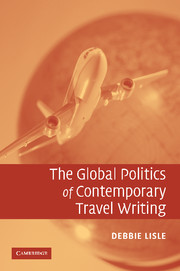Book contents
- Frontmatter
- Contents
- List of illustrations
- Preface
- ‘Travelogue’
- 1 Introduction: the global imaginary of contemporary travel writing
- 2 Between fact and fiction: the generic boundaries of travel writing
- 3 The cosmopolitan gaze: rearticulations of modern subjectivity
- 4 Civilising territory: geographies of safety and danger
- 5 Looking back: utopia, nostalgia and the myth of historical progress
- 6 Engaging the political: contemporary travel writing and the ethics of difference
- Bibliography
- Index
2 - Between fact and fiction: the generic boundaries of travel writing
Published online by Cambridge University Press: 22 September 2009
- Frontmatter
- Contents
- List of illustrations
- Preface
- ‘Travelogue’
- 1 Introduction: the global imaginary of contemporary travel writing
- 2 Between fact and fiction: the generic boundaries of travel writing
- 3 The cosmopolitan gaze: rearticulations of modern subjectivity
- 4 Civilising territory: geographies of safety and danger
- 5 Looking back: utopia, nostalgia and the myth of historical progress
- 6 Engaging the political: contemporary travel writing and the ethics of difference
- Bibliography
- Index
Summary
I don't believe in coming clean.
Bruce Chatwin to Paul TherouxHow had he travelled from here to there? How had he met this or that person? Life was never so neat as Bruce made out.
Paul Theroux on Bruce ChatwinBefore Bruce Chatwin died in 1989, he and Paul Theroux discussed whether travel writing was legitimised primarily by fact or fiction. Although both authors routinely drew from the intellectual fields of literature, science, anthropology, poetry, politics and history, Theroux believed that travel writers ‘record what the eye sees’, whereas Chatwin – who hated the term travel writer – preferred to ‘embroider’ his adventures with fictional embellishments. Chatwin was much happier concealing the mundane aspects of his own journey in favour of more fantastic literary descriptions, whereas Theroux believed the challenge of travel writing was including the ‘how’ of travel – the minutiae about how you get from one place to another – alongside personal observations and descriptions of foreign cultures. Chatwin and Theroux never doubt these twinned authorities, they simply disagree over which should be emphasised, and which is more persuasive for the reader. The different positions advocated by Chatwin and Theroux reveal the tension at the heart of all travel writing: it must authorise itself through both fact and fiction. This chapter examines the different ways in which facts and fictions are arranged in travel writing and argues that these competing authorities cannot be divorced from the legacy of colonialism.
- Type
- Chapter
- Information
- The Global Politics of Contemporary Travel Writing , pp. 27 - 67Publisher: Cambridge University PressPrint publication year: 2006

